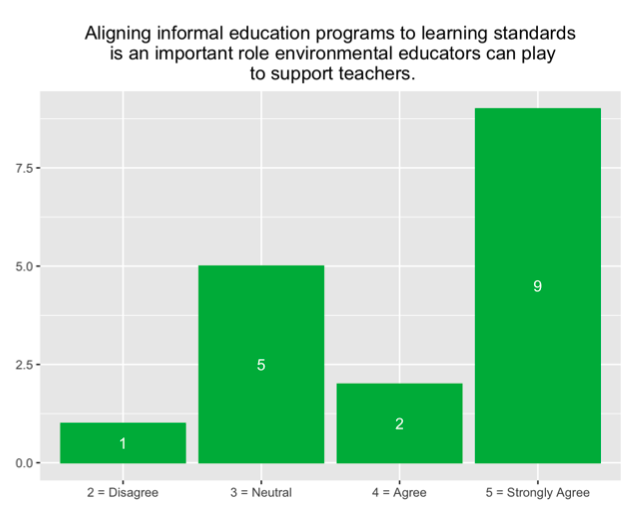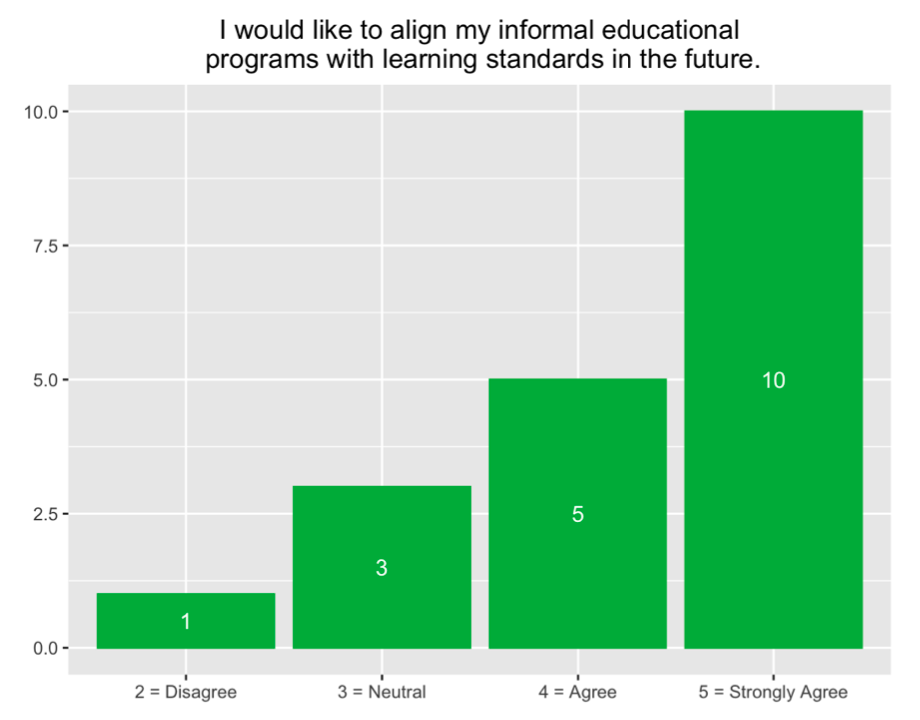Video: EEAC Lunch and Learn—The Role of Standards in Environmental Education Programs 5/21/2024
Report: PDF (542 KB, 6 pages).

MEETING SUMMARY
Report: An Exploration of the Role of Learning Standards in Environmental Education Programs
October 1, 2024
Link to Lunch and Learn Recording
Link to presentation slidedeck
Introduction:
May 21 Meeting, Hosted by the Environmental Advisory Council of NYC (EEAC)
On May 21, 2024, EEAC hosted an informal “Lunch and Learn” meeting to explore the role of learning standards in environmental education programming. The inspiration for the event was a robust conversation on the organization’s list-serv regarding the benefits of adding learning standards to field trip promotional materials:
“We recently started an overhaul of how we list/share our learning objectives and aligned state learning standards for each of our school programs we offer. But I am curious, how are other similar EE orgs formatting standard alignments these days? Are non-formal edu places even listing the corresponding NYS learning standards when advertising your classes to schools? Ten or so years ago teachers were very interested in having info on how the field trips aligned to their curriculum (often noting their principal required it for approval to take a trip). Does anyone else find that this doesn’t seem to be as much of a concern/priority anymore?”
– google group post, March 4, 2024.
Responses from 6 different educators each representing a different organization echoed a similar confusion or curiosity to discuss further.
Planning the Lunch and Learn
Five members of the EEAC Steering Committee, each representing a different organization that provides environmental education programming to New York City Public Schools (NYCPS), gathered to develop a meeting framework and recruit field experts who could offer insights on
the topic. The committee invited Greg Borman, The Director of Science for NYCPS, and Mallory Easton, a former science teacher who had recently transitioned out of the classroom to work with the Billion Oyster Project as a Teaching and Curriculum Specialist, to share their experiences and advice.
Survey Results
Additionally, the team disseminated a pre-survey to environmental education professionals across the EEAC network to identify their approaches and questions about standard alignment. Due to a low response rate, the survey remained open for further reach after the event.
During the weeks of May 1 to May 28, 2024 EEAC received survey participation from the following 18 organizations/affiliations.
Affiliations of Respondents:
- ● Christodora: Nature, Learning, Leadership
- ● GrowNYC
- ● On a Wing and a Prayer
- ● Sarah Lawrence College Center for the Urban River at Beczak
- ● Gaia Scholastic; Garrison School District
- ● City Parks Foundation
- ● Wave Hill
- ● Sanitation Foundation
- ● New York City Parks and Staten Island Greenbelt
- ● New York University and Sands Point Preserve Conservancy
- ● New York City Department of Environmental Protection
- ● Killer Snails
- ● Former Harbor School teacher
- ● Brooklyn Bridge Park Conservancy
- ● Putnam Northern Westchester BOCES
- ● Battery Park City Authority
- ● Brooklyn Botanic Garden
- ● Hudson River Park Trust
The following figures display the preliminary survey results:





Based on the Lunch and Learn conversation and survey results, EEAC has organized our findings below:
Themes and Recommendations
Theme 1: Environmental education (EE) programs in NYC utilize a diversity of approaches for standards alignment and EE professionals want clarity around best practices to guide their work.
There is no unified approach to aligning informal environmental education experiences to learning standards. The field of EE in NYC delivers a wide variety of programs available to teachers that are grounded in real-world learning and environmental stewardship, and with that a great breadth and depth of context knowledge, but the role standards play remains murky.
Recommendation #1:
The field of environmental education would benefit from additional training centered around practical examples of how standards alignment can support learning in informal settings. This need is present for both seasoned professionals who have seen the role of standards change over time and those who are emerging in the field and building up their professional competencies in program facilitation and development. The NYCPS Science Department is well positioned to bring back its partners meeting where this type of training could be delivered.
Recommendation #2:
The role of teachers in the NYCPS systems is shifting away from the development of original curriculum to the use and adaptation of high-quality off-the-shelf materials like Amplify Science. Having a clearer roadmap of what curriculum is used widely across grade levels and content areas could provide EE organizations a better understanding of how to shape and market enrichments to align with the progression of learning units. This approach could be more efficient and practical then standard alignment, especially in one-off program offerings like field trips. A partner login is available to see Amplify Science units and materials. You can obtain this information by emailing Greg Borman directly, GBorman@nyc.schools.gov
Theme 2: Peer to peer learning is an approach we can take to collectively hone our practices and establish practical examples of standard alignment for the wider community.
Recommendation #1:
Environmental educators are not the only informal educators who struggle with the role standards should play in their work. Informal educators teach in all content areas (art, STEM, literacy, etc.) and best practices can be shared across fields to demonstrate more practical examples of what successful standard alignment can look like. The NYC STEM Education Network and the New York Museum Education Roundtable are two examples of intermediaries that could be consulted to understand how other disciplines approach standard alignment. If EEAC is able to host another Lunch and Learn about the topic, guest speakers from these organizations may be consulted.
Recommendation #2:
Professional learning opportunities for NYCPS classroom teachers are also great professional learning opportunities for informal educators. Collaborative sessions allow for these two groups of educators to network and share ideas on how to build bridges with one another. If your organization is running a professional learning session, consider leaving spots open for informal educators to help create community and to generate new ideas of connectivity. And if you supervise environmental educators, build in time for them to attend professional development sessions to bring back learning to your organization.
More about EEAC
EEAC is a non-profit volunteer-run organization originally founded in 1974 to act as an advisory group to the New York City Public Schools when environmental education was a developing field. Now some fifty years later, the mission has shifted to “cultivating an inclusive community committed to increasing its capacity to understand and address NYC’s environmental and related societal challenges.“
eeac-nyc.org
Join the Conversation
Follow us on our socials:
